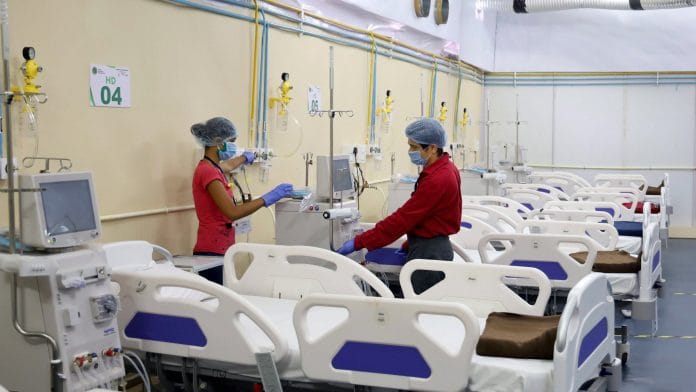New Delhi: A team of doctors at AIIMS Jodhpur is conducting an observational study to find whether prone positioning — making people lie on their bellies — can improve oxygen levels in Covid-19 patients.
The trial, which started recruiting patients this month, is expected to continue till October.
Maya Gopalakrishnan from AIIMS Jodhpur, who is leading the study, said, “Prone position has been tried in other diseases like ARDS, in which lungs are filled with inflammatory soup like fluid due to various reasons preventing normal gas exchange.”
She added, “In Covid-19, there were early social media reports where doctors found it useful. Further rigorous research studies are ongoing, including in our centre at AIIMS Jodhpur.”
Used for ARDS patients since 2013
Prone positioning has been recommended in ARDS (Acute respiratory distress syndrome) patients since 2013, when clinical trials showed it significantly reduced death risk among the patients on ventilators.
However, it is not yet well understood whether prone positioning can benefit Covid-19 patients, some of who develop symptoms similar to ARDS.
A recent observational study, published in JAMA Internal Medicine, showed that prone position for awake, spontaneously breathing patients with Covid-19 severe hypoxemic respiratory failure was associated with improved oxygenation.
Sanja Jelic, Associate Professor at Columbia University Medical Center, who was one of the authors of this study, told ThePrint that the results of their study were encouraging enough for medical practitioners to plan more studies to analyse prone positioning in Covid patients.
“While lying on the back, lung fluid that occurs in ARDS accumulates in the bottom lung regions, and the heart and abdominal contents further compress these dependent lung regions. This leads to non-uniform ventilation,” Jelic said.
The top and frontal lung units, which are regions that receive less of the blood circulation, get delivered a higher volume of ventilation when a person is lying on their back.
The lung regions which receive more blood are left poorly ventilated, leading to hypoxemia — or abnormally low level of oxygen in the blood.
“Prone positioning leads to a more homogeneous distribution of ventilation than lying on the back, improving matching of ventilation and perfusion (rate of blood delivered to a tissue),” Jelic explained.
Gopalakrishnan explained this further by using an interesting analogy.
“Imagine there are huge ‘factories of gas exchange’ where the carbon dioxide from the body are exchanged with oxygen from outside (lung alveloi). There are highways besides these factories which carry the oxygen from here to all over the body (the capillaries with red blood cells),” she said.
“In Covid-19, some factories are closed but the highway trucks keep coming and return empty-handed, while some factories have oxygen but the highways are blocked (by small clots). In prone position, the factories which are working and the highways which are open are better matched,” she said.
Apart from allowing uniform ventilation, prone position allows lung secretions to get drained out, instead of getting pooled up in various areas in the lungs, according to the authors.
Also read: People are fed up, but world is entering new & dangerous Covid phase, warns WHO chief
Study design
The study will be conducted in two phases. In the first phase, Covid-19 patients will be put in a prone position to see if their oxygen levels improve, as measured by a finger probe.
The patients will be assigned to one of the two groups. The first group will remain prone (on their belly) for 10 minutes, then lie sideways on their right and then their left for 10 minutes, and then on their back for 10 minutes. At the end of each phase, oxygen saturation will be measured.
Patients in the second group will go through the same steps in reverse order. If the first phase of the study shows promise, phase 2 will be initiated.
In the second phase, new Covid-19 patients will be assigned to one of the two groups — intervention and control arm.
The patients assigned to the intervention group will undergo the cycle of different sleeping positions — first prone, then lying on the left and right side, respectively, and then on their backs. Patients will be kept in each position for 30 minutes. Three such cycles will be repeated in the day in the second phase of the study.
The control group patients will receive usual care and stay in whichever position they are comfortable with for the rest of the time.
The team will study the effect of the intervention on the requirement of ventilatory support and mortality as compared to the control group.
Any position deemed uncomfortable and reducing the saturation to unsafe levels will be discontinued immediately.
Prone positioning may not be suitable for everyone
Proning may not be suitable for some like those who are pregnant or very obese or have some chest wall problems, Gopalakrishnan said.
She added that though there are no specific side-effects, some patients may not be comfortable in prone position. Moreover, it is not fully understood for which patients it will work. These questions are being addressed by research, Gopalakrishnan said.
She added that her team is already seeing some benefits in patients. It hopes to recruit 120 patients for the study.
Also read: I study coronavirus in a highly secured biosafety lab – here’s why it’s safer than outside






